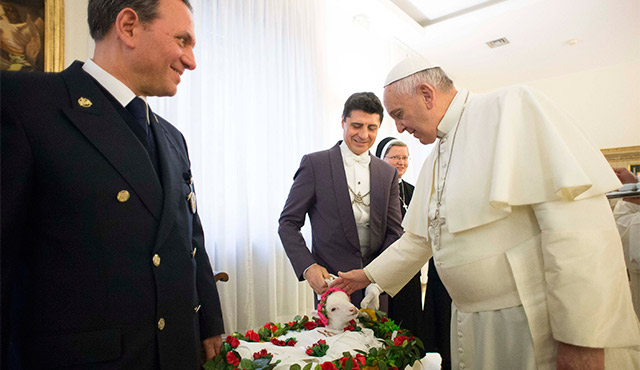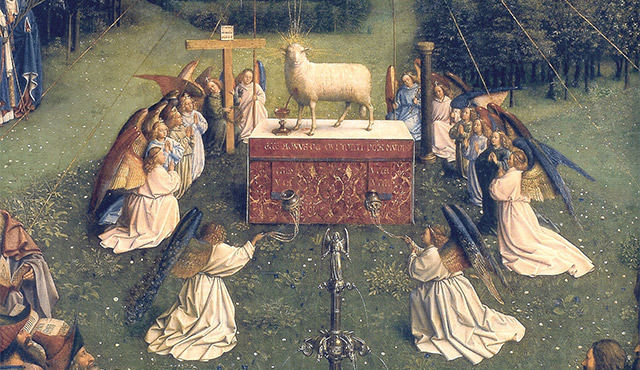From very nearly the beginning to very nearly the end, the lamb is one of the most frequently referenced and profoundly symbolic images found in the Holy Bible. In both the Old Testament and the New Testament there are passages in which the lamb is used to vividly define humanity’s relationship with God and with each other. Some of these have, in fact, become so ingrained in the popular culture that even the non-religious find them familiar and recognizable.
For example, in the fourth chapter of Genesis we see how Abel’s favorable offering of an unblemished lamb, “the firstlings of his flock and their fat portions,” in sacrifice to God arouses a murderous jealousy in his brother Cain. Later, in the book of Exodus, the Hebrews are spared from God’s plague upon the Egyptians of striking down all of the firstborn through the marking of lamb’s blood on their doorposts and are, by this first Passover, released from their bondage in Egypt.
In the Gospel of John, Jesus Christ’s ultimate mission and sacrifice are made clear in the words of John the Baptist, “Behold, the Lamb of God who takes away the sin of the world.” In the Gospel of Luke Jesus sends his disciples out on a mission to preach the good news with the words, “Go; behold, I send you out as lambs in the midst of wolves.” In the final book of the New Testament, Revelation, the writer describes his vision of the multitude “…who came out of the great tribulation, and they have washed their robes and made them white in the blood of the lamb.”
How the lamb came to be such a favored symbol for the writers of the Hebrew Bible (the Old Testament) and, of course, the New Testament is quite straightforward. For the ancient Hebrews, sheep and lambs were very important animals, providing everything the people needed, such as wool, milk, and meat. With the lambs, though, there was something more than just providing the physical necessities of food and clothing.
They were also remarkable for their character, including their unmistakable innocence and quiet acceptance even when led to slaughter. Father Troy Schneider, parochial vicar of Holy Family Cathedral in Orange, explains that the lamb provides an example to humanity to “approach God through humility and innocence.” Seeing this relationship from the other direction, the prophet Isaiah gives us the image of God as the Good Shepherd, “Like a shepherd He sends his flock; He gathers up the lambs with His arms; he carries them close to his heart.”
We even have the example of Jesus using the image of the lamb in reference to others. In the “lambs in the midst of wolves” verse from Luke, Fr. Troy says that Jesus is giving two messages. “It is not only a warning of a difficult situation ahead,” he says, “but a vision of the kingdom to come.” That is, God’s kingdom is described in Isaiah as, “A wolf and a lamb will graze together,” and in Revelation, “…the lion will lie down with the lamb.”
Of course, for Catholics and all Christians it is Jesus Christ who brings to fruition all of the symbolism of the lamb in the scriptures. “The Messiah is the sacrifice to overcome all sacrifices,” explains Fr. Troy. “Christ represents the unblemished lamb, the fulfillment of all prophecy.”
That Christ is the ultimate Passover sacrifice is confirmed by Paul and Peter in their New Testament books. Paul states it very clearly in his first letter to the Corinthians, “For Christ, our Passover Lamb, has been sacrificed.” Peter tells us in his first letter that believers have been redeemed “not by perishable things like silver or gold, but by precious blood like that of an unblemished and spotless lamb, namely Christ.” Fr. Troy goes on to remind us that “what Jesus did saved all humanity, not only the Jews.”
Jesus in the image of the lamb goes beyond just the sacrifice, however. He is not just the man who led a humble, sinless life and was led quietly to slaughter, the sacrifice to atone for humanity’s sins and reconcile us with God. Through the resurrection, the book of Revelation shows us the lamb victorious over death, sitting on his throne, and leading those “who came out of the great tribulation.”
As we come out of the contemplative period of Lent and enter the joyous season of Easter, Fr. Troy notes some of the lessons that modern-day Catholics and Christians can learn from these images of the lamb. “It comes down to leading by example,” he says. “Our example isn’t criticizing or judging.” He continues that we should work on “our own sense of sacrifice” to be Jesus’ hands and feet in the world. “We can be the lamb, working with Christ within us in a humble and pure way.”


